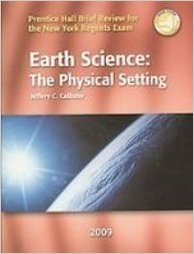
Earth Science: The Physical Setting
1st Edition
ISBN: 9780133200409
Textbook solutions
All Solutions
Page 4: Review Questions
Exercise 1
Step 1
1 of 3
**Observation** is the act or the process of **perceiving** a certain object or event in an environment and its surroundings **using human senses** such as *vision (sight), auditory (hearing), tactile (touch), olfactory (smell), or gustation (taste).*
Step 2
2 of 3
Among the choices in this exercise, the statement that best serves as an observation is the student describing the rock as “black” and “shiny” since it was an **inference through visual inspection**.
Therefore, the correct choice is (**4**).
Result
3 of 3
4
Exercise 2
Result
1 of 1
2
Exercise 3
Result
1 of 1
1
Exercise 4
Result
1 of 1
2
Exercise 5
Result
1 of 1
2
Exercise 6
Result
1 of 1
4
Exercise 7
Result
1 of 1
3
Exercise 8
Result
1 of 1
4
Exercise 9
Result
1 of 1
2
Exercise 10
Result
1 of 1
2
Exercise 11
Result
1 of 1
2
Exercise 12
Result
1 of 1
2
Exercise 13
Result
1 of 1
2
Exercise 14
Result
1 of 1
3
Exercise 15
Result
1 of 1
3
Exercise 16
Step 1
1 of 2
the density of water is $1 g/cm^{3}$
so, the student can fill a cylinder with water and places the plastic beads. beads have density higher than the water $(1.2 g/cm^{3})$ will sink to the bottom of cylinder and beads with $0.6 g/cm^{3}$ density will float.
so, the student can fill a cylinder with water and places the plastic beads. beads have density higher than the water $(1.2 g/cm^{3})$ will sink to the bottom of cylinder and beads with $0.6 g/cm^{3}$ density will float.
Result
2 of 2
he will sort them according the variations in densities by using water
Exercise 17
Step 1
1 of 2
pour water to a known level in graduated cylinder and record the volume $V_{1}$, then immerse the irregular sample in water then the level of water goes up, record the new value of volume $V_{2}$. the difference between the two values equals the volume of the irregular sample$V_{S}$.
$V_{S}=V_{2}-V_{1}$
Result
2 of 2
by recording the difference between the two volumes
Exercise 18
Result
1 of 1
3
Exercise 19
Result
1 of 1
2
Exercise 20
Result
1 of 1
1
Exercise 21
Result
1 of 1
3
Exercise 22
Result
1 of 1
cyclic changes are the movement of celestial objects (sun, moons, planets), seasonal events, water and rock cycles.
non cyclic changes are asteroids impacts, hurricanes, earthquakes and volcanic eruptions.
non cyclic changes are asteroids impacts, hurricanes, earthquakes and volcanic eruptions.
Exercise 23
Result
1 of 1
3
Exercise 24
Result
1 of 1
3
Exercise 25
Result
1 of 1
1
Exercise 26
Result
1 of 1
3
Exercise 27
Result
1 of 1
3
Exercise 28
Result
1 of 1
2
Exercise 29
Step 1
1 of 2
Using alternative resources for natural petroleum products is the best way to conserve nonrenewable resources.
Result
2 of 2
3
Exercise 30
Result
1 of 1
2
Exercise 31
Result
1 of 1
heat, sound, visible light and nuclear radiation. volcanic ash and gases from volcanic eruptions.
Exercise 32
Result
1 of 1
1
Exercise 33
Result
1 of 1
urban and industrial environments are the highest in the pollutants levels
Exercise 34
Result
1 of 1
3
Exercise 35
Result
1 of 1
3
Exercise 36
Result
1 of 1
4
Exercise 37
Result
1 of 1
4
Exercise 38
Result
1 of 1
4
Exercise 39
Result
1 of 1
4
unlock

